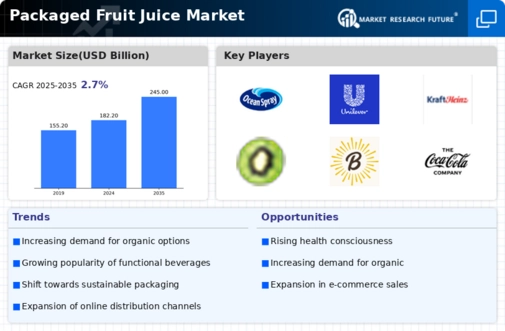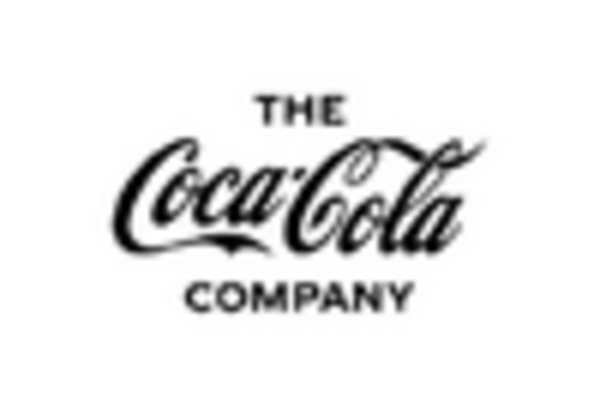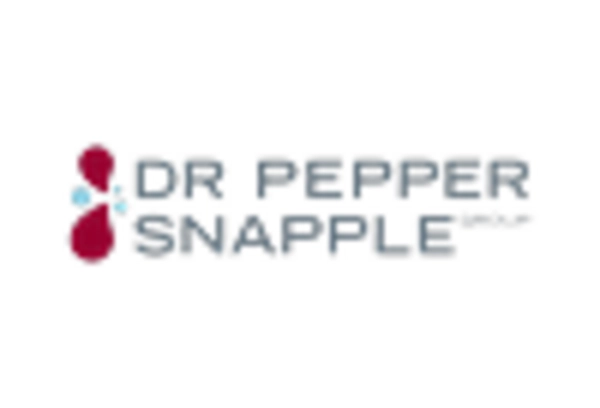Convenience and On-the-Go Consumption
The Packaged Fruit Juice Market is witnessing a surge in demand for convenient, ready-to-drink options. As lifestyles become increasingly fast-paced, consumers are gravitating towards products that offer portability and ease of use. Single-serve packaging and multi-pack options are particularly appealing to busy individuals seeking quick and nutritious beverage choices. Market analysis indicates that the convenience segment is expected to account for a substantial share of the overall market, with a projected increase in sales of portable juice products. This trend is prompting manufacturers to innovate in packaging design and distribution strategies, ensuring that their offerings meet the evolving needs of consumers. The emphasis on convenience is likely to shape the future landscape of the Packaged Fruit Juice Market.
Growing Focus on Functional Beverages
The Packaged Fruit Juice Market is increasingly integrating functional benefits into juice products. Consumers are not only looking for refreshing beverages but also for those that offer health benefits, such as enhanced immunity, digestive health, and energy boosts. This trend is reflected in the rising popularity of fortified juices that contain added vitamins, minerals, and probiotics. Market data suggests that the functional beverage segment is projected to grow at a rate of 10% over the next five years. As health-conscious consumers seek products that contribute to their overall well-being, manufacturers are likely to invest in research and development to create innovative functional juice offerings. This focus on health benefits is expected to drive growth within the Packaged Fruit Juice Market.
Rising Demand for Natural Ingredients
The Packaged Fruit Juice Market is experiencing a notable shift towards natural and organic ingredients. Consumers are increasingly seeking products that are free from artificial additives and preservatives. This trend is driven by a growing awareness of health and wellness, as well as a desire for transparency in food sourcing. According to recent data, the market for organic fruit juices has expanded significantly, with a projected growth rate of approximately 8% annually. This demand for natural ingredients is compelling manufacturers to reformulate their products, ensuring that they align with consumer preferences for clean labels and authentic flavors. As a result, brands that prioritize natural ingredients are likely to gain a competitive edge in the Packaged Fruit Juice Market.
Increased Availability of Exotic Flavors
The Packaged Fruit Juice Market is diversifying with the introduction of exotic and unique flavor profiles. Consumers are becoming more adventurous in their taste preferences, seeking out juices that offer novel experiences. This trend is leading to the incorporation of lesser-known fruits and blends that appeal to a broader audience. Market Research Future indicates that the introduction of exotic flavors is contributing to a rise in sales, particularly among younger demographics who are eager to try new products. Brands that successfully innovate with unique flavor combinations are likely to capture the attention of consumers and differentiate themselves in a competitive market. The exploration of exotic flavors is poised to play a crucial role in the evolution of the Packaged Fruit Juice Market.
Sustainability and Eco-Friendly Packaging
The Packaged Fruit Juice Market is increasingly prioritizing sustainability, particularly in packaging solutions. As environmental concerns gain prominence, consumers are favoring brands that adopt eco-friendly practices. This includes the use of recyclable materials and sustainable sourcing of ingredients. Recent studies indicate that a significant portion of consumers is willing to pay a premium for products that demonstrate a commitment to sustainability. Consequently, manufacturers are exploring innovative packaging options that minimize environmental impact while maintaining product integrity. This shift towards sustainability is not only beneficial for the planet but also enhances brand loyalty among environmentally conscious consumers. The emphasis on eco-friendly practices is likely to shape the future direction of the Packaged Fruit Juice Market.

















Leave a Comment